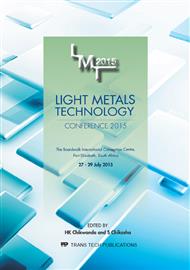[1]
F. H. Froes, S. J. Mashl, J. C. Hebeisen, V. S. Moxson, and V. A. Duz, The technologies of titanium powder metallurgy, Journal of the Minerals Metals, 56(2004) 46-49.
DOI: 10.1007/s11837-004-0252-x
Google Scholar
[2]
M.T. Jia, D. L. Zhang, and B. Gabbitas., Comparison of Blended Elemental (BE) and Mechanical Alloyed (MA) Powder Compact Forging into Ti-6Al-4V Rocker Arms, Key Engineering Materials, 520 (2012) 82-88.
DOI: 10.4028/www.scientific.net/kem.520.82
Google Scholar
[3]
C. Leyens and M. Peters, Titanium and Titanium alloys: Fundamentals and Applications, WILEY-VCH Verlag GmbH and Co KGaA, 305 (2003) 34-43.
Google Scholar
[4]
Z. Zak Fang, Powder Metallurgy Titanium-Challenges and Opportunities, International Journal of Powder Metallurgy, 46(2010).
Google Scholar
[5]
Nadakuduru, V.N., Zhang, D., Raynova, S., Cao, P. Gabbitas, B. Mechanical behaviour of Titanium, Ti-6Al-4V (wt %) alloy and Ti-47Al-2Cr (at %) alloy produced using powder compact forging. Advanced Materials Research, 275 (2011)186-191.
DOI: 10.4028/www.scientific.net/amr.275.186
Google Scholar
[6]
J.W. Qiu, Y. Liu, B. Liu, B. Wang, Earle Ryba, and H. P. Tang., Optimizing the hot-forging process parameters for connecting rods made of PM titanium alloy, Journal of Materials Science, 47 (2012) 3837-3848.
DOI: 10.1007/s10853-011-6239-4
Google Scholar
[7]
E. Parteder, H. Riedel, and R. Kopp., Densification of sintered molybdenum during hot upsetting: experiments and modelling, Materials Science and Engineering: A, 264 (1999) 17-25.
DOI: 10.1016/s0921-5093(98)01118-6
Google Scholar
[8]
K T Kim and H. C. Yang, Densification behaviour of titanium alloy powder during hot pressing, Materials Science and Engineering: A, 313 (2001) 46-52.
DOI: 10.1016/s0921-5093(01)01147-9
Google Scholar
[9]
R. J. Green, A plasticity theory for porous solids, international Journal of Mechanical Science, 14(1972) 215-224.
Google Scholar
[10]
H. A. Kuhn and C. L. Downey, Deformation characteristics and plasticity theory of sintered powder materials, International Journal of Powder Metallurgy, 7(1971) 15-25.
Google Scholar
[11]
S. Shima and M. Oyane, Plasticity theory for porous metals, International Journal of Mechanical Science, 18 (1976) 285-291.
DOI: 10.1016/0020-7403(76)90030-8
Google Scholar
[12]
J. Svoboda, H. Riedel, and R. Gaebel, A model for liquid phase sintering, ActaMaterialia, 44(1996) 3215-3226.
DOI: 10.1016/1359-6454(95)00440-8
Google Scholar
[13]
S. M. Doraivelu, H. L. Gegel, J. S. Gunasekera, J. C. Malas, J. T. Morgan, and J. F. Thomas, A new yield function for compressible P/M materials, International Journal of Mechanical Science, 26 (1984) 527-535.
DOI: 10.1016/0020-7403(84)90006-7
Google Scholar
[14]
A. L. Gurson, Continuum Theory of Ductile Rupture by Void Nucleation and Growth: Part I—Yield Criteria and Flow Rules for Porous Ductile Media, Journal of Engineering Materials and Technology, 99 (1977) 2-15.
DOI: 10.1115/1.3443401
Google Scholar
[15]
V. Tvergaard, On localization in ductile materials containing spherical voids, International Journal of Fracture, 18 (1982) 237-252.
DOI: 10.1007/bf00015686
Google Scholar
[16]
F. P. Bowden and D. Tabor., The friction and lubrication of solids. Oxford: Clarendon Press, (1950).
Google Scholar
[17]
S. P. Shenoy. (2013) Lubricant Choices and Forging Cost. Forging magazine.
Google Scholar
[18]
Z.M. Hu, J.W. Brooks, T.A. Dean, Experimental and theoretical analysis of deformation and microstructural evolution in the hot-die forging of titanium alloy aerofoil sections, Journal of Materials Processing Technology, 88 (1999)251–265.
DOI: 10.1016/s0924-0136(98)00407-5
Google Scholar
[19]
W.R.D. Wilson, S.R. Schmid, J. Liu, Advanced simulations for hot forging: heattransfer model for use with the finite element method, Journal of Materials Processing Technology(2004) 155–156.
DOI: 10.1016/j.jmatprotec.2004.04.399
Google Scholar
[20]
N. Aravas, On the numerical integration of a class of pressure-dependent plasticity models, International Journal for Numerical Methods in Engineering, 24 (1987) 1395-1416.
DOI: 10.1002/nme.1620240713
Google Scholar
[21]
C. Huang and J. Cheng, Forging simulation of sintered powder compacts under various frictional conditions, International Journal of Mechanical Sciences, 44(2002) 489-507.
DOI: 10.1016/s0020-7403(01)00107-2
Google Scholar


